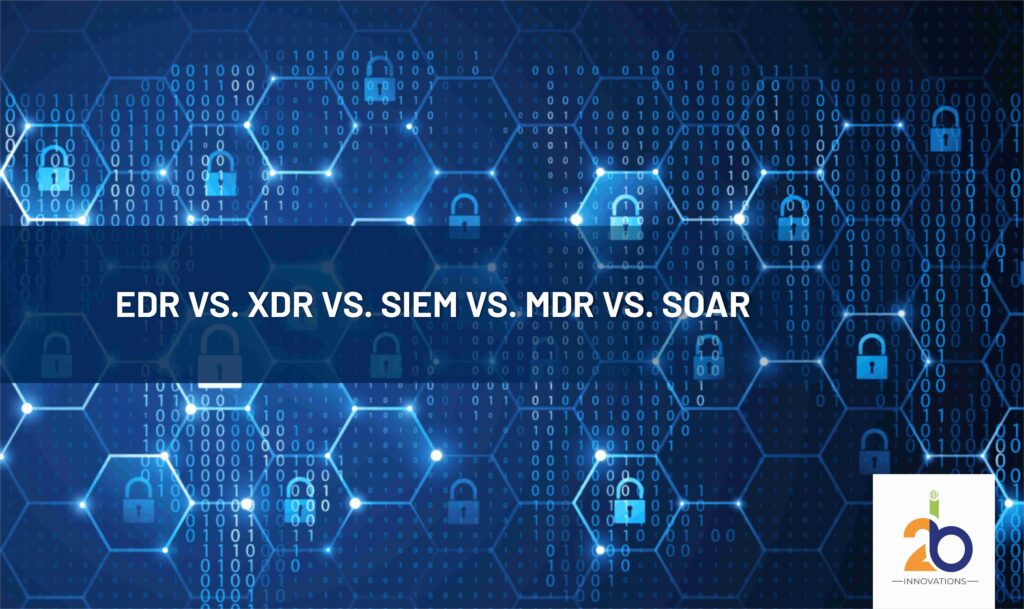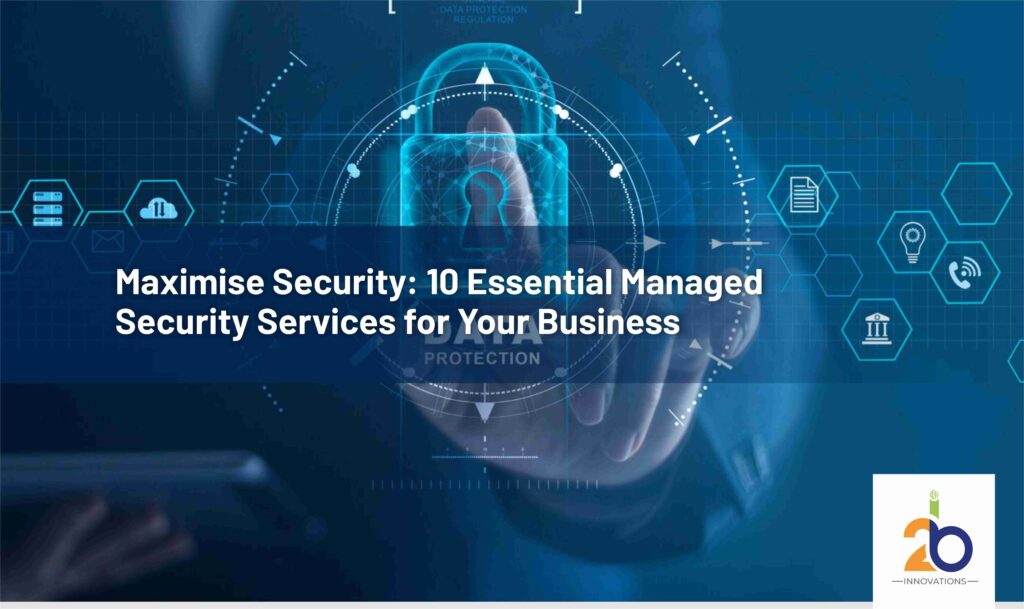
In today’s evolving digital world, organizations grapple with an increasing number of security threats. To counter these security issues, various tools and software have been developed in recent years. EDR (Endpoint Detection and Response), XDR (Extended Detection and Response), SIEM (Security Information and Event Management), MDR (Managed Detection and Response), and SOAR (Security Orchestration, Automation, and Response) are some of the tools and solutions that have been developed to combat the problems of security threat. Each one of these tools has distinct capabilities and focuses on different aspects of cybersecurity. This article delves into the differences among these tools and how their synergistic use makes a holistic security solution.
What is EDR (Endpoint Detection and Response)?
Endpoint Detection and Response tool is a crucial tool in the realm of cybersecurity, as it is used for detecting, investigating, and responding to advanced endpoint threats. This tool has been developed as a strategic response to traditional endpoint protection solutions because of prevents organizations from all kinds of cyber attacks.
EDR’s functioning is akin to DVR as EDR records relevant behaviours to identify incidents that excluded preventive measures. EDR users can have complete visibility into all security-related end-point activities. This tool has various functions, some of which are that it logs network connections, process launches, driver loading, registry changes, disk access, memory access, and registry changes.
Anton Chuvakin, a former vice president and security analyst at Gartner who is now a security product strategist, coined the term EDR in 2013. It emerged as a response to the old antivirus software and Endpoint Protection Platforms (EPPs) in thwarting emerging threats.
As the threat landscape is changing and attacks are becoming more sophisticated, the importance of EDR has seen a major growth. This is because it provides complete visibility into all security-related end-point activities and helps in detecting, investigating, and responding to advanced endpoint threats.
What is XDR (Extended Detection and Response)?
XDR (Extended Detection and Response) is a cybersecurity solution designed to identify, investigate, and respond to advanced threats that stem from various sources like the cloud, networks, and email. This security platform is based on SaaS where the organization’s existing security solutions are aligned into a single security system.
An XDR platform gathers raw telemetry data from a range of technologies which include cloud apps, email security, identity, and access control. It improves threat visibility and reduces the time required to detect and respond to a cyber attack by integrating data from multiple security systems.
Compared to other tools, XDR is the latest cybersecurity concept, developed to help IT professionals sort through the flood of security alerts and identify threats quickly. The need for XDR arose from the inability of traditional security technologies to detect and respond to complex threats across multiple vectors.
In today’s cybersecurity world, XDR is recognized as a critical approach for adequate coverage against complex threats. It was created to detect and respond to attacks from a variety of vectors, including the cloud, network, and email. In short, XDR provides cross-domain threat-hunting and forensic investigation capabilities.
What is SIEM (Security Information and Event Management)?
SIEM (Security Information and Event Management) is a tool that supports enterprises in detecting, assessing, and responding to security threats quickly to prevent the business from any disruptions. It includes security event management (SEM) and security information management (SIM).
SIEM enhances the visibility of the IT environment, hereby, allowing the teams to respond to the perceived events and security incidents more efficiently through communication and collaboration.
SIEM emerged early in the millennium when businesses understood the need for more comprehensive security solutions capable of managing huge amounts of data produced by their systems. Today, businesses generate so much data, which can not be managed manually. Thus, SIEM is a need of the hour.
A modest SIEM system generates 1,500 events per second from up to 300 event sources. As SIEM provides a centralized view of all security-related data, SIEM is required for organizations to monitor any kind of suspicious activity. SIEM also provides valuable capabilities like forensic investigation and compliance reporting which is important for incident response and adherence to compliance standards.
What is MDR (Managed Detection and Response)?
MDR (Managed Detection and Response) is a cybersecurity service that is typically offered by Managed Security Service Providers (MSSPs). MDR usually incorporates a combination of technology, processes, and people that come together to identify and combat cyber threats.
MDR is designed to provide continuous detection, response, and protection from attacks. They leverage machine learning to investigate, alert, and reduce cyber threats as much as possible.
MDR originated in the mid-2010s. This was when organizations identified the necessity of a comprehensive security solution capable of dealing with the increasing cyber threats which are becoming more and more sophisticated. According to a report by ResearchAndMarkets.com, the global MDR market is expected to grow from 2.6 billion in 2017 to 5.6 billion by 2027.
MDR is said to be one of the most essential tools in modern cybersecurity. This is so because it offers a proactive approach to threat detection and response, helps organizations to quickly identify and mitigate threats, provides continuous monitoring, and responds to cyber threats quickly. It is also less costly as organizations do not need extra staff to handle MDR.
What is SOAR (Security Orchestration, Automation, and Response)?
SOAR (Security Orchestration, Automation, and Response) is a software stack, that facilitates companies to collect information about security threats and respond to security events minimizing dependence on human intervention.
SOAR platforms are utilized to enhance the efficacy of physical and digital security operations. SOAR technology also helps in task coordination, execution, and automation between various individuals and tools within a single platform. In a nutshell, it is a technology used to protect networks from cyber threats, attacks, and access from unauthorized devices. SOAR has gained friction in the cybersecurity industry as it gives a platform for incident management, reducing the need for manual procedures and various technologies. SOAR also enables enterprises to efficiently plan, monitor, and report on incident management activities, which also enhances incident response times and security position.
What are the differences between EDR, XDR, SIEM, and SOAR?
EDR, XDR, SIEM, MDR, and SOAR are the tools that have been developed to combat the problems of security threats. Their goal is to provide advanced identification of threats, analytics, and response capabilities to organizations.
However, it should be noted that there are significant differences in these tools and they are:
- EDR solutions are made to gather, and correlate endpoint activity to identify, analyze, and respond to security threats. EDR is mainly used for detecting and responding to threats on endpoints to enhance incident response time, as well as for forensic investigation.
- XDR is like the advanced version of EDR offering detection, analytics, and response capabilities across endpoints, networks, servers, cloud workloads, SIEMs, and many other platforms. XDR provides a consolidated view of multiple tools and attack methods, which facilitate threat detection, alerting, in-depth analysis, and real-time response.
- SIEM solutions play a critical role in gathering, aggregating, and analyzing large volumes of log data which are obtained from various sources across the organization. They are primarily used for compliance, threat identification, and security incident management. SIEM is well known for its broad approach as it covers almost all the data sources within the enterprise that are required to be stored for a lot of usage.
- MDR is a cybersecurity service that is typically offered by Managed Security Service Providers (MSSPs). MDR provides a unique cybersecurity solution as it combines technology and human expertise to perform threat identification, monitoring, and response. MDR also enables its clients to outsource the identification of and response to security incidents to a third-party provider so that threats can be identified quickly and there can be very little impact on the business activities.
- SOAR solutions are outlined to enable organizations to automate and streamline their incident response and security operations. First, they receive data from SIEM and then work on resolutions. They are primarily utilized to coordinate and carry out tasks between different teams, tools, and platforms. The capabilities which are present in SOAR but not in SIEM are as follows:
Automated Response: SOAR can automatically cite investigation path workflows and reduce the time it takes to resolve alerts. However, on the other hand, SIEM requires manual interference from an analyst to understand whether further investigation is needed or not.
Orchestrian: SOAR can adapt and automate tasks across various security tools and systems which allows businesses to refine their incident response process. However, SIEM is typically focused on the collection and analysis of log data.
Multi-vendor support: The SOAR platform allows amalgamation with a wide range of security tools and systems across any vendor. On the other hand, SIEM solutions primarily work with data from the same vendor.
In short, SOAR is designed to automate and improve the efficiency of tasks. XDR provides a consolidated view of multiple tools and attack methods, which facilitate threat detection, alerting, in-depth analysis, and real-time response. EDR primarily focuses on endpoints. MDR provides continuous and ongoing identification of cybersecurity threats and responses.SIEM is used for the identification of threats, compliance, and management of incidents.
FREQUENTLY ASKED QUESTIONS (FAQs):
- What Is the Relationship Between SIEM and SOAR?
SIEM and SOAR both enhance an organization’s ability to identify, analyze, and respond to security threats. However, on one end SIEM focuses on collecting and analyzing data from multiple sources, while on the other hand, SOAR aims at automating and optimizing the response to such data. After receiving data from SIEM, SOAR works on the resolutions. If a SOAR is not present, then the security teams would need to act on information and insights from an SIEM through a variety of external interfaces.
2. Does XDR replace SIEM and SOAR?
No, XDR can not replace SIEM and SOAR. SIEM gathers, aggregates, analyzes, and stores a huge quantity of log data from all business areas. Originally, SIEM necessitated the collection and storage of all events and log data from virtually any source of the organization for a variety of use cases. After receiving the data from SOAR, SIEM starts the resolution process. To summarise, SIEM platforms typically lack log repository and analysis capabilities. SOAR responds in different ways than SIEM. The functionality of SOAR and SIEM complement each other, but, it should be noted that XDR can not replace the two as in most cases it does not have a holistic approach to efficiently supporting security operations. As there are limitations in XDR, its use cases revolve around security teams augmenting their threat identification and incident response capabilities with an SIEM.
3. Do I need all three tools: SIEM, SOAR, and XDR?
The choice of choosing between SIEM, SOAR, and XDR is primarily based on the goals and objectives of an organization. All three of these tools can help with both security and incident response.
SIEM necessitates the collection and storage of all events and log data from virtually any source of the organization for a variety of use cases. The main function of SIEM is to manage security data and events.
SOAR is an incident response tool that automates incident response processes. It enables security teams to coordinate and automate processes that involve multiple security technologies and platforms.
XDR is designed to identify, investigate, and respond to advanced threats that stem from various sources like the cloud, networks, and email. It provides a unified view of security data from endpoints to networks to servers to cloud workloads to SIEMs.
Organizations do not require all of the three tools. An organization may feel that a combination of SIEM and SOAR is enough, or that XDR can be the best solution to its needs. Selecting a perfect tool is a critical assessment that an organization makes to fulfill its specific needs and goals


